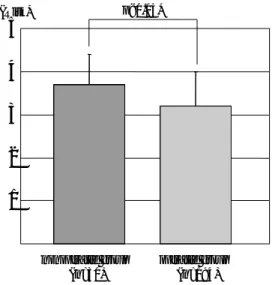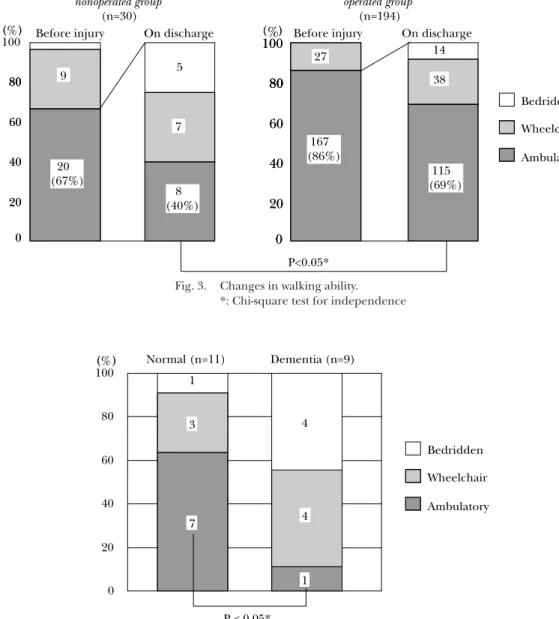INTRODUCTION
Proximal femoral fracture commonly occurs in the elderly, and the treatment is in principle early surgery, early mobilization, and rehabilita-tion. With recent advances in medicine, surgery is performed even though there are consider-able systemic problems. However, for unavoid-able reasons such as the presence of severe comorbidity, nonoperative treatment is some-times chosen. There are few reports on the indi-cations and functional prognosis of nonopera-tive treatment for proximal femoral fracture. In this study, we investigated the functional and survival prognoses of elderly patients with proxi-mal femoral fractures who underwent nonoper-ative treatment, and compared these findings with those of operative cases.
PATIENTS ANDMETHODS
A total of 224 patients composed of 30 males and 194 females aged 60 years or more who were admitted to Kofu National Hospital, which is an acute care hospital, between January 1997 and July 2002 for the treatment of proximal femoral fracture were recruited as subjects. Their ages on injury ranged from 60 to 100 years with a mean of 83.2 years. The fracture types were femoral neck fracture in 77 cases and intertrochanteric fracture in 147 cases. The frac-ture was on the right femur in 111 cases and the left femur in 113 cases.
Of 224 patients, 30 were given nonoperative treatment (nonoperated group) for reasons of severe comorbidity on admission (12 cases), patient’s or family’s choice (11 cases) and dementia (7 cases). The remaining 194 patients underwent operative treatment (operated group).
Poor Prognosis in Elderly Patients Receiving Nonoperative Treatment
for Hip Fracture: A Study of 224 Cases at Kofu National Hospital
Tetsuo H
AGINO, Eiichi S
ATO1), Shingo M
AEKAWA1), Kazuhiro B
ANDO1),
Hisahiro T
ONOTSUKA, Morihito T
OKAI, and Yoshiki H
AMADA1)Department Orthopaedic Surgery, National Hospital Organization Kofu National Hospital, 11-35 Tenjin-cho, Kofu, 400-8533, and
1)Department Orthopaedic Surgery, Interdisciplinary Graduate School of Medicine and
Engineering, University of Yamanashi,Yamanashi, Japan
Abstract: Among 224 patients aged 60 years of older with hip fractures, 30 underwent nonoperative treatment. The functional and survival prognoses of these patients were investigated and compared with patients who underwent surgery. The operated and nonoperated groups did not differ in age on injury, dementia status and in-hospital mortality. However, the nonoperated patients had a higher risk on admission and poorer functional prognosis than did the operated patients. Furthermore, within the nonoperated group, patients with dementia had significantly poorer walking ability than those without.
Key words: Hip fracture, Nonoperative treatment, Elderly
Received March 24, 2005 Accepted June 10, 2005
The surgical procedure included open reduc-tion and internal fixareduc-tion using compression hip screws in 121 cases, canulated cancellous hip screws in 19 cases, gamma nail in 9 cases, and hemiarthroplasty with a noncemented pros-thesis in 36 cases.
The functional and survival prognoses of these patients were investigated. The operated group and nonoperated group were compared with respect to age, status of dementia, number of deaths, and physical status on admission. Fur-thermore, the two groups were compared in terms of walking ability on discharge for those who were able to walk alone or with a cane before injury. The physical status on admission was assessed based on 10 parameters including age, status of anemia, liver function and renal function, and each case was classified into Risk 1 to 5 using a previously reported classification system1)(Fig. 1).
RESULTS
The ages on injury were 82.8 years in the non-operated group and 83.2 years in the non-operated
group, with no significant difference between the two groups. On comparing the fracture type, the nonoperated group had 15 cases (50%) of femoral neck fracture and 15 cases (50%) of intertrochanteric fracture, while the operated group had 62 cases (32%) of femoral neck frac-ture and 132 cases (68%) of intertrochanteric fracture, with no significant differences between the two groups. Regarding dementia status, 16 of 30 patients (53.3%) in the nonoperated group had dementia compared with 81 of 194 (41.8%) in the operated group, with no significant differ-ence between the two groups. Regarding sur-vival prognosis, the rate of hospital mortality was 10% (3 cases) in the nonoperated group com-pared with 4.1% (8 cases) in the operated group, also with no significant difference between the two groups (Table 1). Next, for the comparison of risk level on admission, Risk 1 to 5 was con-verted into scores of 1 to 5, respectively. The mean risk score was 3.7 ± 0.7 in the nonoperated group and 3.2 ± 0.8 in the operated group, show-ing significantly worse physical status in the non-operated group (Fig. 2). Before injury, 20 patients in the nonoperated group and 167 patients in the
1. Age: 85 years or above.
2. Anemia: Hemoglobin 12 g/dl or below for males, 11 g/dl or below for females 3. Liver function: GOT 40 IU/l or above, GPT 35 IU/l or above
4. Renal function: BUN 20 mg/dl or above 5. Abnormal electrolytes
6. Inflammation status: CRP 0.5 mg/dl or above 7. Pancreatic function: Urinary glucose (+)
8. Abnormal chest X ray, with a known medical diagnosis
9. Abnormal electrocardiogram (such as arrhythmia and ischemic changes) 10. Physical status: Presence of comorbidity
Risk 1 : Meets none of the above 10 items 2 : Meets 1-2 items
3 : Meets 3-4 items 4 : Meets 5-6 items 5 : Meets 7 or more items
operated group were able to walk alone or with a cane. Eight of the 20 patients (40%) in the non-operated group and 115 of the 167 patients (68.9%) in the operated group regained their abil-ity to walk on discharge, showing a significantly lower walking ability in the nonoperated group (Fig. 3). Moreover, in the nonoperated group, patients with dementia had significantly lower walking abilities than did those without demen-tia (Fig. 4).
DISCUSSION
There are few reports on nonoperative treat-ment for hip fracture. Jain et al.6)studied 50,235 patients above the age of 65 years each with a diagnosis of hip fracture and reported that 10.6% were nonoperatively treated. Also, Ions and Stevens5)reported that among 158 patients with femoral neck fracture, 23 (14.6%) with severe medical comorbidity were nonoperatively treated. Although we consider operative treat-ment to be the first choice for hip fracture in the elderly, 30 among 224 patients (13.4%) with hip fractures were nonoperatively treated in the present study. Based on the above finding, one may assume that nonoperative treatment is cho-sen for 10 to 15% of elderly patients with hip fractures, while the majority of these patients receive operative treatment.
In the present study, since most of the patients who underwent nonoperative treat-ment were inoperable cases due to comorbid medical conditions or dementia, they had a mean risk score of 3.7 ± 0.7 on admission, which was significantly higher compared with the operated patients. Consequently, the func-tional prognosis was poorer compared to the
1
2
3
4
5
(Risk) nonoperated group (n=30) operated group (n=194) p<0.05*Fig. 2. Comparison of physical status on admission. *: Mann-Whitney’s U test
Table 1. Characteristics of the study population (n=224)
nonoperated group operated group
p
n(%) n(%)
Number of patients 30 (13.4) 194 (86.6) — Mean age (years) 82.8 ± 9.4 83.2 ± 7.3 N.S.a
Fracture type Femoral neck 15 (50) 62 (32) N.S.b Intertrochanteric 15 (50) 132 (68) Dementia 16 (53.3) 81 (41.8) N.S.b In hospital death 3 (10.0) 8 (4.1) N.S.c N.S.: Not significant. a: Mann-Whitney’s U test.
b: Chi-square test for independence. c: Fisher’s exact probability test.
operated group. Moreover, within the nonoperated group, the patients with dementia had signifi-cantly lower walking abilities compared to those without dementia. Jain et al.6)reported that the thirty-day mortality rate in the nonoperatively treated patients (18.8%) was higher than the rate in operatively treated patients. Ions and
Stevens5)also reported a 60.8% mortality rate at 6 months in nonoperatively treated patients with hip fractures and severe medical comorbid-ity. In the present study as well, the hospital mortality was 10% (3 cases) in the nonoperated group compared with 4.1% (8 cases) in the oper-ated group, showing a higher rate in the nonoper-Ambulatory
P<0.05*
Bedridden Wheelchair Before injury On dischargeOn
20 40 60 80 ( ) 0 100 80 20 40 60 80 ( ) 0 100% 80 20 40 60 80 ( ) 0 100 80 20 40 60 80 ( ) 0 % 80 8 (40%) 7 5 9 20 (67%) (69%)115 38 14 167 (86%) nonoperated group (n=30) operated group (n=194)
Before injury On discharge 27
Fig. 3. Changes in walking ability. *: Chi-square test for independence
Normal (n=11) 3 1 7 0 20 40 60 80 100 4 4 1 Dementia (n=9) P < 0.05* Ambulatory Bedridden Wheelchair ( ) ( )%
Fig. 4. Walking ability on discharge in the nonoperative group. *: Fisher’s exact probability test
ated group although there was no significant dif-ference. Although the above results indicate poor functional and survival prognoses in inop-erable cases treated by nonoperatively, Hornby et al.4)and Hamanishi3)reported on the useful-ness of conservative treatment. Hornby et al.4)randomly assigned 106 patients with extra-capsular hip fractures to internal fixation or traction treatment. At the end of 6 months, no statistical difference in mortality, pain or com-plications was noted. Hamanishi3)used direct traction and rehabilitation in bed as conserva-tive treatment for peritrochanteric fractures and reported that this low-cost approach achieved acceptable results. Therefore, nonop-erative treatment may be one option for the treatment of hip fractures in patients without dementia and with good physical status. Howev-er, continuation of traction therapy is expected to be difficult in patients with severe dementia or severe medical comorbidity. Since surgery is not a direct cause of death in the elderly2), even in those with hip fractures efforts should be made to regain their preoperative physical sta-tus by actively performing surgery as soon as possible to achieve better functional prognosis.
Although the results of the present study clearly showed a poor prognosis in patients who did not undergo surgery, 19 of 30 who were treated by nonoperative modalities did not choose conservative treatment. Rather, surgery
was not possible due to comorbidity or demen-tia on admission. To clearly show that the prog-nosis is affected by the treatment modality, a randomized prospective study is necessary, but such a study is difficult at present and will be considered in the future. Finally, the treatment method for patients with dementia or severe medical comorbidity is a topic for future investi-gation.
REFERENCES
1) Hagino T, Harada J, Tonotsuka H, Ono T, Ishizu-ka K, Hamada Y: Preoperative general condition and clinical prognosis after hip fracture. J East Jpn Orthop Traumatol. 15: 189–193, 2003 (in Japanese).
2) Hagino T, Ishizuka K, Iwakubo T, Mochizuki K, Watanabe N, Ono T, et al.: Hospital mortality of hip fracture in the aged. Rinsho Seikei Geka (Clin Orthop Surg.) 38: 307–310, 2003 (in Japanese).
3) Hamanishi C.: Conser vative treatment for trochanteric fracture in the elderly. Seikei Saigai Geka (Orthop Surg Traumatol.) 44: 813–819, 2001 (in Japanese).
4) Hornby R, Evans JG, Vardon V.: Operative or conservative treatment for trochanteric fractures of the femur. A randomised epidemiological trial in elderly patients. J Bone Joint Surg. Br 71: 619–623, 1989.
5) Ions GK, Stevens J.: Prediction of survival in patients with femoral neck fractures. J Bone Joint Surg. Br, 69: 384–387, 1987.
6) Jain R, Basinski A, Kreder HJ.: Nonoperative treatment of hip fractures. Int Orthop. 27: 11–17, 2003.

